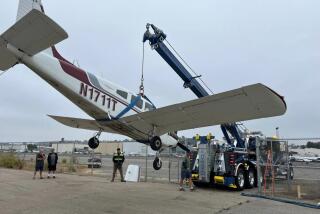Copters in Collision Were Following ‘See-and-Be-Seen’ Policy
The police helicopter pilots involved in the fatal mid-air collision over Irvine were following “see-and-be-seen” safety guidelines observed by law enforcement agencies throughout Southern California and were not subject to Federal Aviation Administration air traffic control, police officials said Wednesday.
In the aftermath of the crash, in which three officers were killed and two were injured, police officials said such helicopter crews frequently operate under stressful working conditions and have few guidelines to avoid such disasters.
Apart from a policy that the aircraft keep safe distances from each other and communicate their locations over radio channels, the pilots follow a “looking out for the other guy” maxim that is largely self-policing, said Lt. George Tawes, a ranking officer in the Los Angeles Police Department’s air-support division.
“There are no hard-and-fast rules up there that I’m aware of,” added Newport Beach police spokesman Kent Stoddard. “Other than providing a courtesy notice so (one) helicopter knows that another has entered their air space, there are no rules.”
Unlike fixed-wing aircraft, helicopters are generally free from FAA regulation, according to agency spokeswoman Barbara Abels. They operate under visual flight rules that “are just like driving your car. You’re responsible as a pilot for the operation of that vehicle,” she said.
Tuesday night’s collision occurred when a Costa Mesa police helicopter, engaged in pursuit of a car theft suspect, radioed over an emergency channel to a Newport Beach aircraft that the suspect was about to enter that city, police said.
Collide Near UC Irvine Campus
The Costa Mesa crew intended to “hand off” the pursuit to Newport Beach counterparts, who could better identify city streets to patrol cars below. Stoddard explained. Seconds later, the two aircraft collided over an open field near the UC Irvine campus.
All three men aboard the Costa Mesa aircraft were killed, while the two officers in the Newport Beach helicopter were injured, police said.
At the moment of collision, both pilots apparently were flying at an altitude of about 500 feet and had to keep their eyes on the fleeing suspect, said an FAA spokesman. That task, plus the need to direct police cars on the ground, typifies the stressful conditions under which the helicopter crews operate, said Huntington Beach Police Lt. Robert Morrison.
“The workload in the cockpits gets very heavy during one of these pursuits,” he said. “You’re trying to keep your eye on the car. . . . You’re watching your instruments to make sure everything is within limits, you’re looking around outside, watching for other aircraft, and you’re directing other police units coming into the pursuit.”
Morrison said the situation becomes even more complicated when police helicopters from several jurisdictions get involved in the chase. At that point, he said, it is crucial that pilots communicate regularly with each over a special radio channel so that all the aircraft converging on a scene can keep a proper distance.
“We’ve had situations where a pursuit starts up in the San Fernando Valley and it goes all the way down to San Diego,” Morrison said. “It can pass through so many jurisdictions that the helicopters are passing the chase back and forth to each other several times.”
Tawes said such incidents are infrequent. When they occur, however, the guidelines for airborne pursuit can vary from one place to the next.
For example, Los Angeles County Sheriff’s Department helicopters usually do not turn over an airborne chase to other law enforcement agencies. Moreover, the department allows its aircraft to fly somewhat closer to other helicopters during a pursuit.
“Our policy is that if it’s a pursuit initiated by us, we maintain involvement until the termination of the incident,” said Deputy Chris Robbins. “If we were to go through the Los Angeles Police Department’s area, for example, we would not relinquish pursuit to the LAPD.”
If an LAPD helicopter got involved in the chase, he added, the Sheriff’s Department aircraft would play the lead role and fly at about 400 feet, while the city police helicopter would fly at 700 feet and provide radio direction to patrol cars.
In the LAPD, Tawes said, officers decide on a case-by-case basis whether its helicopters will continue a pursuit over a city border. In any high-speed chase, he added, pilots must be concerned about safety in the air as well as on the ground.
“The responsibility lies with the pilots in command of all aircraft to see and avoid each other,” he said.
More to Read
Sign up for Essential California
The most important California stories and recommendations in your inbox every morning.
You may occasionally receive promotional content from the Los Angeles Times.










